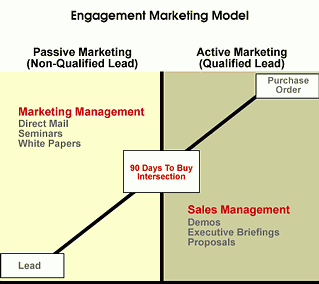Today, more than ever, IT salespeople are looking for more qualified leads and shorter sales cycles.
One sales process that we recommend to our consulting clients is called "Engagement Marketing.” It shortens sales cycles and immediately increases qualified IT sales prospects for the sales team.
Engagement Marketing is a planned process of rotating prospects through a series of marketing devices that communicate your IT specialization and educate them about why they should buy from you instead of your competition. To increase qualified lead traffic, marketing departments should manage marketing leads similar to a sales forecast by identifying them in a pipeline where they actively move leads from a passive to an active status based on their "qualification.”
Every salesperson knows that just getting leads from a trade show, direct mail campaign or print ad does not mean they are qualified. Leads must be cultivated through an interactive process until they "mature.”
IT sales prospects fall into two types of categories:
- Those who will buy within 90 days (regardless to the length of your average IT sales cycle); and
- All others
Yes, major IT deals can take six months or longer to sell, but salespeople don't have six-month quotas - they have annual quotas for which they are evaluated monthly. So, they need to spend more time with prospects that are in the 90-day buy cycle to actively hit their quota.
In Any Given Week, Sales Forecasting Is Just a Snapshot of Time.
Sales prospects are continually being moved in their qualification status each month based on adjustments in budget issues, Wall Street and business priorities.
So a prospect's qualification status is always a moving target and must be managed until it becomes a qualified lead that the sales team can close. But, many salespeople hang on to all prospects because they fear the possibility of not being there when a prospect is ready to buy.
By using an Engagement Marketing model, IT firms can move short-term buying prospects into an interactive education model and educate them to buy faster while simultaneously not wasting your sales team's time chasing prospects who are at the end of the rainbow.
The Benefits of Engagement Marketing Are:
- Interacting with the prospect until they move into a buying mode
- Allowing the prospect to understand more about the business pains of their industry through an education source (your firm)
- Helping prospects see your firm as a specialist and reduce their need to "check out" your competition
- Accelerating the prospect's need to buy from your sales executives sooner by communicating business value of your IT offering in a non-sales environment.
How Do You Deploy Engagement Marketing?
- Develop multiple marketing engagement tools to move prospects through a continuous series of interactions with your company (white papers, eNewsletters, seminars, etc.).
- Have the sales team qualify all prospects.
- Segment all prospects into passive marketing or active marketing categories. (Active buying in 90 days, passive marketing after 90 days).
- Continually engage prospects with an engagement model until they are within 90 days of buying, and then have the marketing team "pass" them from a passive marketing mode to an active marketing mode so the sales team can sell them.

"It's not who is in your forecast; it's who you sell!"



